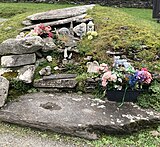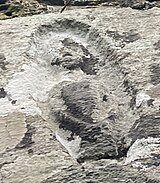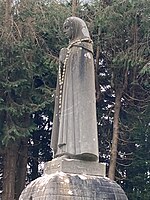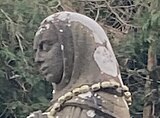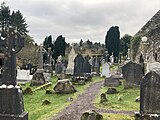St Gobnait's well


St Gobnait's well is the usual name given to a religious complex built on the site of a 6th or 7th century nunnery[1] near Ballyvourney, County Cork, Ireland. Consisting of a holy well, two churches and a graveyard, its origins date to the medieval period. The site is associated with the 8th century saint Gobnait, and today it is a place of veneration and pilgrimage, where people walk around the site reciting the rosary (an act known locally as "doing the rounds in Ballyvourney", Irish: Turas Ghobnatan)[2] to pray for the dying and dead, with the 11th of February (Gobnait’s feast day), and Whit Sunday being the two central date of gathering.[3]
Gobnait was an 7th or 8th century Irish saint, believed to have lived locally, and known as the patron saint of beekeepers after she sent a swarm of bees to chase away cattle rustlers.[4] The site consists of a well and 1951 statue of Gobnait, which is separated by a road from a graveyard containing a late medieval Catholic Church (known as St Gobnait’s Church, now in ruins)[1] and a more recent Protestant church, both of which are disused. The site is a popular location for rites of the rosary, having a well defined circular path for pilgrims to walk in prayer, either in remembrance of the dead or to ask Gobnait to aid the dying.
Background

Gobnait was an 8th century saint born in County Clare but moved for a time the island of Inisheer, where she founded a church
She is most famously depicted in the stained glass window for the Honan Chapel by the Irish artist Harry Clarke."[5] Gobnait became a healer and established a convent in Ballyvourney, County Cork.[5]
Description

The site consists of a holy well associated with Gobnait and a modern graveyard supposedly built around Gobnait's burial mound. The graveyard is active today with most gravestones dated from the early 20th century to the present, and appears as overcrowded, with many of the graves huddled close together. It is built on the grounds of a medieval Protestant church and the ruins of an older Catholic church known as St Gobnait's Abbey.[6]
The well is marked by a life-sized limestone statue of Saint Gobnait, commission locals from the Irish sculptor Seamus Murphy, and completed in 1951, and unvelied that year on Whit Sunday (3 May ) of that year.[6][7][8] Murphy was one of the best known Irish sculptors as the time, and his design is renowned for its "simplicity and beauty".[6] Gobnait is shown standing on a pedestal, under which is a beehive. The sides of the pedestal are lined with carvings of bees and stags, reflecting her legend, while a set of independent rosary beads are hung from her neck.[6]
A small, weather-damaged female figure carved from limestone on a window of the Catholic abbey was once though to be a representation of Gobnait, but is now assumed by archaeologists to be a Sheela na gig (a type of erotic/fertility stone carving sometimes placed on the walls of Romanesque churches (11th–12th centuries) but with earlier origins. By tradition, female pilgrims hooping to have a child would climb the wall to rub the figures' genitals for luck.[3]
Gallery
Venerated features
-
St Gobnait's supposed burial mound
-
Faded Sheela na gig on an outer wall of the Catholic church
-
View the statue of St Gobnait
-
Detail
Modern Churches and graveyard
-
The Protestant church
-
Engraving on the Protestant church
-
Gravestones
-
Modern High cross, with St Gobnait's Abbey in background.
References
- ^ a b "St Gobnait, Ballyvourney, Cork". Corpus of Romanesque Sculpture in Britain and Ireland, British Academy. Retrieved 16 January 2024
- ^ "Naomh Gobnait i saol na muintire". RTÉ. Retrieved 16 January 2024
- ^ a b Zucchelli (2007), p. 138
- ^ Whitty (2020)
- ^ a b Rogers 1997, p. 209.
- ^ a b c d O'Suliivan, Marc."Cork In 50 Artworks, No 16: Statue of St Gobnait at Ballyvourney, by Séamus Murphy". Irish Examiner, 9 August 2021. Retrieved 16 January 2024
- ^ "Gobna(i)t". Dictionary of Irish Biography and the Royal Irish Academy. Retrieved 16 January 2024
- ^ "Seamus Murphy 1907-1975 Sculptor". Munster Technological University. Retrieved 16 January 2024
Sources
- Harbison, Peter. "Pilgrimage in Ireland: The Monuments and the People". Syracuse University Press, 1995. ISBN 978-0-8156-0312-2
- Hopkin, Alannah. West Cork: The People and the Place. Cork: Collins Press, 2008.
- O'Kelly, Michael. "St. Gobnet's House, Ballyvourney, Co. Cork". Journal of the Cork Historical and Archaeological Society, volume 57, 1952
- Ray, Celeste. "The Origins of Ireland’s Holy Wells". Archaeopress Publishing, 2014.
- Rogers, Patricia (1997). "Bees and Butterflies: Two Drawings by Harry Clarke". Journal of Glass Studies. 39. JSTOR 24190174.
- Ua hÉaluighthe, Diarmuid. "St. Gobnet of Ballyvourney". Journal of the Cork Historical and Archaeological Society, volume 57, 1952
- Whitty, Audrey. "St. Gobnait, the patron saint of beekeeping: Design drawings for stained glass windows by Harry Clarke. Corning Museum of Glass, 26 September 2020
- Zucchelli, Christine. Sacred Stones of Ireland. Cork: Collins Press, 2007. ISBN 978-1-8488-9726-7
